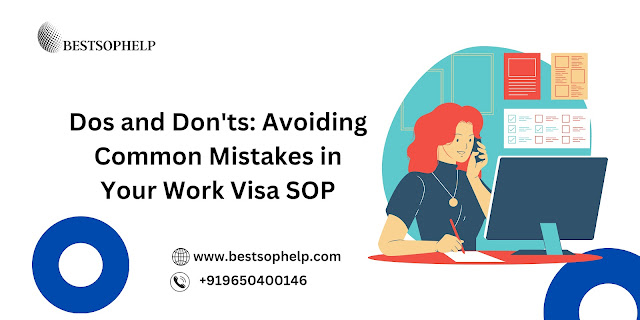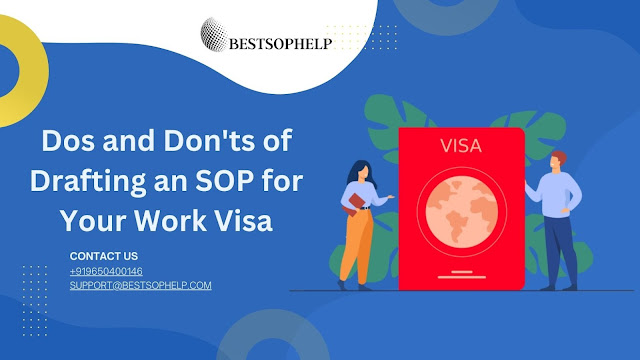Dos and Don'ts: Avoiding Common Mistakes in Your Work Visa SOP
In the modern globalized world, pursuing career opportunities abroad has become a common aspiration for many individuals. Securing a work visa is often a crucial step in realizing this dream. One of the essential components of your work visa application is the Statement of Purpose (SOP). A well-crafted SOP can significantly enhance your chances of obtaining the desired work visa, while mistakes in the SOP can lead to rejection. In this blog post, we will explore the dos and don'ts of creating a compelling SOP for work visa application.
Dos:
1. Understand the Purpose of the SOP: Before you begin writing your SOP, it's crucial to understand its purpose. The SOP serves as an opportunity for you to introduce yourself, explain your reasons for wanting to work in the chosen country, and demonstrate how your skills and experiences align with the job and the host country's requirements.
2. Research the Country and Company: Thorough research is the foundation of a strong SOP. Understand the culture, work environment, and values of the country you're planning to move to. Similarly, research the prospective employer to showcase your genuine interest and compatibility with their organization.
3. Tailor Your SOP for Each Application: Avoid using a generic SOP for all your applications. Customize your SOP for each specific job and country. Highlight aspects of your background that directly relate to the job and show your commitment to contributing positively.
4. Emphasize Your Unique Qualities: Identify your unique skills, experiences, and achievements that make you stand out. Convey how these qualities can benefit the employer and the country's workforce.
5. Structure and Clarity: Organize your SOP with a clear structure. Typically, an SOP includes an introduction, your background, reasons for choosing the country, reasons for choosing the job, and your future goals. Use concise language and avoid jargon to ensure clarity.
6. Show Genuine Passion: Demonstrate your genuine enthusiasm for the job and the opportunity to work in the host country. Passion can help you leave a positive impression on the reviewing committee.
Don'ts:
1. Plagiarism: Never plagiarize content from the internet or from sample SOPs. Plagiarism is easily detectable and can lead to immediate rejection of your application. Your SOP should be a reflection of your thoughts and experiences.
2. Generic Statements: Avoid generic and vague statements that could apply to any applicant. For instance, phrases like "I am a dedicated and hardworking individual" without specific examples to support this claim are not impactful.
3. Irrelevant Information: While your background might be diverse and impressive, include only the information that is directly relevant to the job and your decision to move. Irrelevant details can make your SOP unnecessarily lengthy and dilute its effectiveness.
4. Negative Language: Maintain a positive tone throughout your SOP. Avoid discussing negative experiences, criticisms, or anything that might cast doubt on your suitability for the job.
5. Excessive Technical Jargon: While it's important to demonstrate your expertise, avoid excessive use of technical jargon that might not be easily understood by individuals outside your field. Your SOP should be comprehensible to a broader audience.
6. Overconfidence: Confidence is important, but avoid coming across as overly arrogant. Instead of stating that you are the "best candidate," provide evidence of your skills and achievements that make you a strong contender.
Common Mistakes to Avoid:
Procrastination: Writing an SOP takes time, so start early to ensure you have ample time for revisions and improvements.
Lack of Proofreading: Grammatical errors, typos, and formatting issues can create a negative impression. Proofread your SOP thoroughly or consider seeking assistance from a proficient friend or professional editor.
Ignoring Guidelines: Many countries and employers provide specific guidelines for SOPs. Make sure to follow these instructions meticulously to avoid unnecessary rejection.
Excessive Length: Stick to the recommended word limit. An excessively long SOP can lose the reader's interest and undermine the impact of your application.
Rushing the Process: Take your time to craft a thoughtful and compelling SOP. Rushing through the process might result in an incomplete or subpar document.
In conclusion, the Statement of Purpose is your chance to communicate your aspirations, strengths, and compatibility with the job and host country. By following the dos and don'ts mentioned in this blog post, you can create a standout SOP that significantly enhances your chances of securing that coveted work visa. Remember, your SOP is not just a formality – it's a powerful tool that can shape your future career endeavors.
Visit now: Sop Help



.jpg)
Comments
Post a Comment